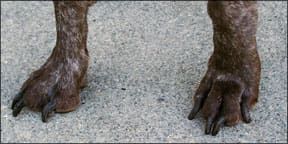Two months ago, I read a news story about a dog owner in Minnesota who had shared her home and her life with her 10-year-old Great Pyrenees for eight years. On December 30, 2008, the dog attacked his owner as she was trying to trim his nails, sending her to the hospital for multiple bite wounds to her arms. The news report on the incident stated, “[The dog owner] was able to reach another room and closed the door, keeping the dog out.”
The owner in this sad story was treated and released from the hospital the same day. The dog is now dead – euthanized at the veterinary hospital for safety reasons, at the owner’s request. Nail-trimming should not be a matter of life and death. Nor should any other routine grooming procedure. If a dog objects strongly to any sort of physical contact or restraint that may occur in the process of ordinary care, a smart, responsible owner needs to take immediate steps to overcome his objections in a positive, nonaversive manner. Fortunately, this process (described in detail below) is not difficult (or dangerous!) to do – but it does take a serious commitment of time.

288
Why not use force?
Most of us are pressed for time, and many dog owners may squirm at the thought of yet another dog-care duty that requires the investment of a lot of time (in addition to other training and exercise chores). So why not simply restrain the dog and firmly tell him “No!” if he growls or otherwise objects to the pedicure or other grooming?
The news story of the Minnesota woman and her Great Pyrenees is sadly instructive in this regard. The article I read quoted the dog’s owner as saying that the dog had always been “very, very touchy” about his paws. She even said he had attacked “mildly” before, but she had been able to get him to stop. “He would growl, and generally I could say, ‘Stop it,’ and get him to stop,” she was quoted as saying. “This morning, it didn’t stop.” She then went on to say that for reasons that remained “unclear,” the dog attacked her.
Wait a second. This dog has been telling her for eight years that he didn’t want her to touch his paws. The owner lays out all the reasons the attack occurred, and then says the reasons for it are unclear? How much clearer could it be? This is a classic example of a human totally ignoring her dog’s attempts to communicate with her, this time with a very tragic ending.
Stress is the underlying factor behind almost all aggression – idiopathic aggression being the rare exception (see “Rage Without Reason,” Whole Dog Journal June 2004). We know that suppressing aggressive behavior doesn’t change aggressive behavior; it just drives it underground where it simmers, likely to smash its way out when the stress becomes too great and pushes the dog over his bite threshold – like it did with this Great Pyrenees. In this dog’s case, at age 10 (advanced age for the giant breeds), there may also have been additional stressors such as arthritis, or other age-related conditions. If grasping his paws to clip nails caused him pain, that would have been an additional stressor that further exacerbated his reaction.
Don’t get me wrong. I’m not condemning the owner’s decision to euthanize a dog who caused her serious injury. It’s difficult, if not impossible, to repair a dog-owner relationship that has been damaged this badly. Rehoming a 10-year-old dog with a history of aggressive behavior isn’t generally realistic, either. The real tragedy was the eight years that led up to the final act in this drama – eight years in which the dog tried as best he knew without hurting his owner, to tell her that nail trimming made him very uncomfortable. Eight years during which the owner could have modified his behavior, rather than suppressing it.
Suppressing behavior
Behavior suppression is a regrettably popular approach to behavior modification in some circles today. This is partly a carryover from old-fashioned training methods. It has also experienced a large resurgence in popularity due to its regular use on a high-profile television show. But its popularity is also bolstered by the fact that, sometimes, it works.
There is something inherently satisfying to us humans when we tell someone to stop doing something and they stop. At least for the moment. What it doesn’t do is change the underlying motivation for the behavior.
Dogs do things that are reinforced – the behavior either makes a good thing happen (positive reinforcement), or makes a bad thing go away (negative reinforcement). A dog is motivated to do a behavior because it works to do one of those two things. They are also motivated to stop doing behaviors that are punished – the behavior makes good things go away (negative punishment), or makes bad things happen (positive punishment).
Aggression, which is initially an emotional response to stress, can be influenced by reinforcement and punishment. Over the years, that Great Pyrenees’s growling in response to having his paws touched was probably negatively reinforced at least some of the time, since wise humans back off when a dog growls. The dog learned that sometimes people stopped touching his paws if he growled. Intermittent reinforcement makes a behavior very durable. When a behavior is reinforced sometimes, it’s hard to make that behavior go away.
However, sometimes the dog’s growling didn’t work. Not only did his owner continued to mess with his paws, when he got more forceful about trying to make the bad thing go away, his owner got violent in response. So the positive punishment stopped the aggressive behavior for the moment, but it didn’t make it go away, and it didn’t alter the dog’s underlying emotional response to the procedure that stressed him. The violence suppressed the behavior, but it didn’t change it.
Modifying behavior
If instead of suppressing his aggression in response to paw handling, his owner had taught the Great Pyrenees to love nail trimming, the pair wouldn’t be mentioned in this article. But another dog and owner well might be. I dare say there are thousands upon thousands of dogs who don’t like having their nails trimmed, and whose discomfort signals in response to the procedure have been suppressed. Their lives – and their humans’ lives – would be much happier if someone took the time to do a little behavior modification.
My own personal canine behavior science lab gives me plenty of nail-trimming material to work with. Three of our four dogs weren’t too happy about pedicures when we first acquired them. Two of the three were unhappy about having their paws touched, much less having their nails trimmed. Dubhy, our Scottie, suffered from severe allergies when we found him. His paws were raw and bleeding. No wonder he was sensitive about them! Lucy the Corgi, on the other hand, is just generally touchy about being touched. Bonnie the Scorgidoodle is fine about touching, even her paws, but doesn’t like the restraint and pressure on her nails that goes along with the clipping. Here’s how we “fixed” each one:

288
–Lucy (sensitive to all touch): Since Lucy was touch sensitive in general, I used counter-conditioning and desensitization to help her overcome her dislike of being touched on her legs and body. (See “Counter-Conditioning and Desensitization to Touch,” previous pages). This also included other grooming procedures – brushing, looking at her teeth, and cleaning her ears – as well as giving her a positive association with restraint and hugging. Our ultimate solution to nail trimming involved the use of her “Wait” behavior. After we had completed her paw/nail clipper-touch desensitization protocol, I did the following:
1.Told Lucy to “Down” and “Wait.”
2.Placed a yummy treat 12 inches in front of her nose.
3.Clipped one nail.
4.Told her “Take it!” so she could jump up and eat the treat.
5.Repeated steps 1 through 4 for each subsequent next nail.
She now absolutely adores the nail clipping procedure, and I clip multiple nails in between “Take it!” cues, always keeping it random so she never knows which nail clip will result in the treat cue.
–Dubhy and Bonnie (unhappy about having paws touched): I also did a paw/clipper touch desensitization protocol with Dubhy, until he was comfortable having his paws touched and his nails trimmed. However, he and Bonnie both have those awful, dense, black toenails that require heavy pressure on the clippers, which they both found aversive despite counter-conditioning. Plus, it’s devilishly hard to know where the quick is on a solid black nail, and despite my most careful attention, from time to I managed to “quick” them both. You can imagine how painful (and aversive) that must be – and how much of a setback that is even to the most careful modification program (see “A Quick Recovery,” next page).
I had to overcome a negative association of my own to implement the ultimate solution to Dubhy and Bonnie’s nail-trimming challenge. A decade ago while conducting a nail-trimmer product review for Whole Dog Journal (“You Nailed It!” February 1999), I tested a nail-grinder. One of my dogs, the wonderful Josie, was a terrier-mix with hairy feet, and I neglected to keep her fur pulled back from the grinder. It got tangled in the mechanism and yanked painfully on her paw. I’ve been reluctant to use a grinder ever since. Yet I knew it was the right answer to my current two dogs’ nail trimming difficulties, so I bucked up and tried it, using a nylon stocking over their paws to hold back their fur. (The nails poked through a hole in the stocking toe for grinding.)
After some desensitization to the sound of the grinder, both Bonnie and Dubhy are much more comfortable with nail trimming (and still get lots of treats). Their nails look better than they ever have in their lives – and we’re all much happier!
Note: The “as seen on TV” battery-powered nail grinders are inexpensive, and have a built-in guard that prevents hair from tangling in the grinder. However, they’re not very powerful, so it takes a while to get the job done and you go through a lot of batteries. The more expensive models that you can find in pet supply stores, catalogs, and Web-based pet supply businesses are worth the extra cost.
Operant conditioning
I often hear dog owners say, “I don’t need to trim my dog’s nails; she runs on pavement (or rocks, or sand) and keeps them worn down herself. “Great,” I think to myself – and sometimes say out loud. “When your dog becomes a less-active senior citizen and no longer wears her nails down, then you’ll face the battle, when it will be even more challenging after all those years to convince her to let you hold her paws and trim her nails.”
If you prefer to let your dog file her own nails, there’s an operant conditioning approach that will still work when your dog is in her golden years. Positive trainer Shirley Chong in Grinnell, Iowa, suggests taking a board 8 to 12 inches wide and 24 to 26 inches long, covering it with slip-proof tape or coarse sandpaper, and teaching your dog to paw at the board to file his own nails. She describes the procedure in detail at shirleychong.com/keepers/nailfile.html. I haven’t tried this procedure yet myself, but I bet all my dogs would enjoy some shaping sessions learning how to do this; it sounds like great fun! The bottom line is, there are a lot of things the owner of the Great Pyrenees could have done over the years to help her dog tolerate, accept, even love having his nails done. If she had, he’d be alive today. If your dog doesn’t like having his nails done, don’t wait; help him learn to love the procedure now. Don’t let nail trimming kill your best friend.
Thanks to Sandi Thompson, of Bravo!Pup Puppy and Dog Training, in Berkeley, California, for demonstrating counter-conditioning and desensitization techniques. For contact information, see “Resources,” page 24.
Pat Miller, CPDT, is Whole Dog Journal’s Training Editor. Miller lives in Hagerstown, Maryland, site of her Peaceable Paws training center. Pat is also author of The Power of Positive Dog Training; Positive Perspectives: Love Your Dog, Train Your Dog; Positive Perspectives II: Know Your Dog, Train Your Dog; and Play with Your Dog.






